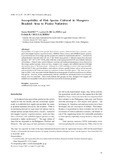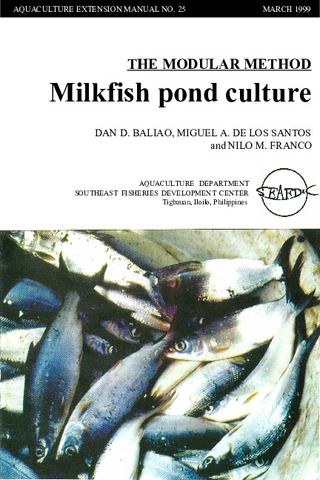Susceptibility of fish species cultured in mangrove brackish area to piscine nodavirus
- Global styles
- MLA
- Vancouver
- Elsevier - Harvard
- APA
- Help

Download URL
www.jstage.jst.go.jpDate
2007Page views
1,517ASFA keyword
AGROVOC keyword
Taxonomic term
Metadata
Show full item record
Share
Abstract
Susceptibility of orange-spotted grouper Epinephelus coioides, Asian sea bass Lates calcarifer, mangrove red snapper Lutjanus argentimaculatus, milkfish Chanos chanos, and rabbitfish Siganus guttatus to piscine nodavirus from orange-spotted grouper was studied by experimental infection. The fish were intraperitoneally injected with 0.05 mL of the filtrate homogenate of infected organs from diseased grouper at 106.8, 105.8 or 104.8 TCID50/fish, while the control group received 0.05 mL of Hanks’ balanced salt solution. Clinical signs such as lethargy, anorexia and darkened pigmentation were observed in the orange-spotted grouper, Asian sea bass, mangrove red snapper, and milkfish injected with high and medium doses of the homogenate. Although no or little mortality occurred in the experimentallyinfected fish 10 days post-inoculation, viral nervous necrosis specific lesions such as severe necrosis and vacuolation in the brain and retina were produced in these four fish species. The virus was reisolated in SSN-1 cells inoculated with the filtrated tissue homogenate of survivors in all doses for all four fish species. However, in the experimentally infected rabbitfish no histological lesion was observed, and no virus was reisolated. These results indicate that grouper, sea bass, mangrove red snapper, and milkfish are susceptible to the piscine nodavirus isolated from diseased grouper.
Suggested Citation
Maeno, Y., de la Peña, L. D., & Cruz-Lacierda, E. R. (2007). Susceptibility of fish species cultured in mangrove brackish area to piscine nodavirus. Japan Agricultural Research Quarterly , 41(1), 95-99. https://doi.org/10.6090/jarq.41.95
Type
ArticleISSN
0021-3551Collections
- Journal Articles [1258]
Related items
Showing items related by title, author, creator and subject.
-
Series: Aquaculture extension manual; No. 25
The modular method: Milkfish pond culture
Baliao, Dan D.; de los Santos, Miguel A.; Franco, Nilo M. (Aquaculture Department, Southeast Asian Fisheries Development Center, 1999)The modular method of milkfish culture (Chanos chanos) described in the manual is an improvement over the traditional extensive method. The manual is intended for the use of fish farmers and aquaculturists, extensionists, ... -
Evaluation of organic and inorganic fertilizers in brackishwater milkfish ponds
Bombeo-Tuburan, Isidra; Agbayani, Renato F.; Subosa, Precilla F. (Elsevier, 1989)The study was conducted in twelve 144-m2 ponds to evaluate the effect of different organic and inorganic fertilizers on the growth, survival, gross production, and profitability of marketable milkfish. The ... -
Milkfish breeding and hatchery technology at SEAFDEC/AQD
Unknown author (Aquaculture Department, Southeast Asian Fisheries Development Center, 1999)Describes the techniques already adopted by the private sector: broodstock management, broodstock diet, commercial fry production, live transport, and larval diet. A list of AQD research publications on milkfish is included.





